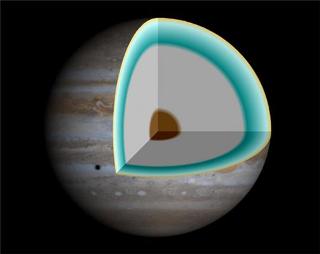Oct 20 2015
Thermal conduction “revealed” starting from the foundations of Physics
It was one of the “missing pieces” in the Theoretical Physics of Materials puzzle and today a group of SISSA researchers has finally found it: for the first time, the phenomenon of thermal conduction has been accounted for by the fundamental laws of quantum mechanics. The study, just published in Nature Physics, will allow scientists to simulate this phenomenon numerically in extreme temperature and pressure conditions, such as those existing inside planets, or for materials, such as covalent glasses or liquids, to which currently available methods do not apply.
 The inner layers of Jupiter – Credits: NASA/R.J. Hall (Wikipedia: https://goo.gl/eZXiRc)
The inner layers of Jupiter – Credits: NASA/R.J. Hall (Wikipedia: https://goo.gl/eZXiRc)
It’s a bit like the difference between preparing a dish following a recipe detailing ingredients and procedure, or trying to do it just by looking at photos of the dish: in many cases good results can also be obtained with the second method but, clearly, knowing the recipe not only guarantees a successful outcome but also allows us to devise variants of the dish, using different and perhaps even tastier ingredients. This also happens in the world of physics, where in some cases the “recipe” is completely lacking and one has to make do with approximate methods (“photos of the dish”). This is, or rather was, the case with thermal conduction, a very common phenomenon in materials. Although well known and extensively studied, so far it has never been given a theoretical description taking into account both the behaviour of atoms – regulated by the laws of classical mechanics – and the behaviour of electrons, which instead follows the laws of quantum mechanics.
“For some reason, despite the phenomenon being very common, this description has just not been available so far”, explains Stefano Baroni, SISSA professor and author of the study. “This has prevented scientists from applying powerful numerical simulation methods – which are successfully used for a large variety of materials, properties and processes – to thermal transport in many technologically and scientifically highly interesting systems”.
“In order to predict the thermal behaviour of materials, we have so far had to use ‘approximate methods’, which have been successfully applied to many of these technological problems”, continues Baroni. “However, these methods suffer some severe limitations when it comes to applying them to covalent glasses and liquids or to materials in extreme pressure and temperature conditions, such as those existing inside planets”. In fact, these conditions - the scientist explains - are so extreme that they cannot be reproduced in the laboratory, and numerical simulation is the only possibility for understanding the heat dissipation mechanisms of planets, an essential element fopr learning about their composition and internal structure.
“To devise a general method for simulating thermal transport processes, scientists were lacking a theoretical framework, which our study has finally provided”, explains Baroni. “Our method is accurate and general, but it requires massive computational resources”. Ulysses, the supercomputing system recently acquired by SISSA, will prove precious in this respect. For more ambitious applications we’ll have to use the supercomputers available in the large computing centres such as CINECA in Bologna, and sophisticated software techniques, such as those being studied at the European Centre of Excellence called MaX (“Materials at the eXascale”), coordinated by the CNR and featuring SISSA as one of its major partners.
Thermal conduction
Have you ever wondered why, when you leave your car in the sun, you get burnt if you touch the car body but not if you touch the seats? The two materials making up the car body and seats are at the same temperature, and yet when you touch them they give completely different sensations. “The property that changes between metal and fabric is thermal conduction, the thermal equivalent of electrical conduction,” explains Baroni. “The metal car body has a much higher conductivity than fabric and so it is much more efficient at transmitting its heat to bodies that come into contact with it (our hand)”.